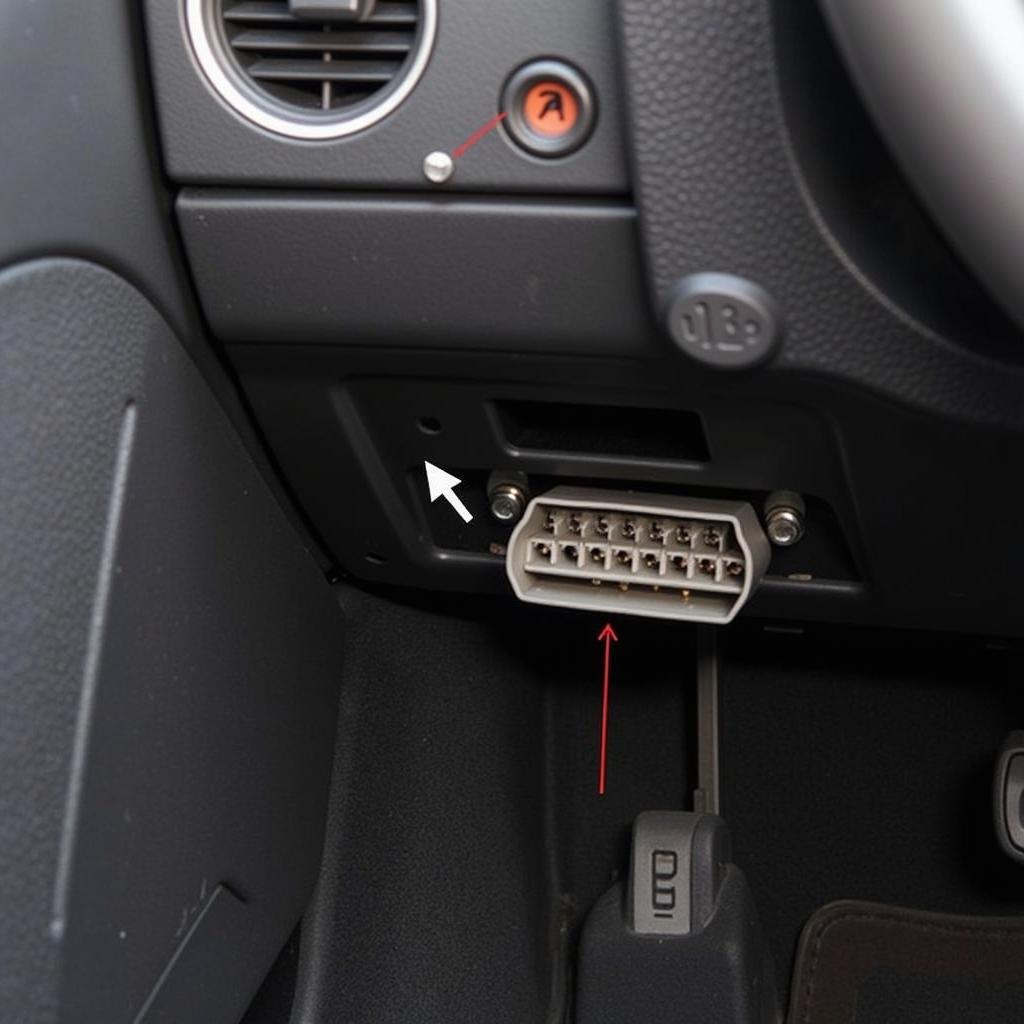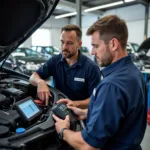Modern vehicles are complex machines, packed with electronic control units (ECUs) that manage everything from engine performance to safety features. Understanding how car diagnostics work is crucial for both car owners and professionals. These diagnostics systems are the key to identifying and resolving issues quickly and efficiently. In this article, we’ll delve into the intricacies of car diagnostic systems.
Decoding the Mystery of Car Diagnostics
Car diagnostics involve using specialized tools and software to communicate with a vehicle’s onboard computer system, often referred to as the OBD-II (On-Board Diagnostics-II) port. This port, typically located under the dashboard, acts as a gateway to the vehicle’s electronic brain. Think of it as a doctor checking a patient’s vital signs. The diagnostic tool retrieves diagnostic trouble codes (DTCs), which are standardized codes that indicate specific malfunctions within the vehicle’s systems.
How Diagnostic Trouble Codes (DTCs) Work
DTCs are five-character alphanumeric codes that follow a specific structure. The first character represents the system affected (e.g., “P” for powertrain, “B” for body, “C” for chassis, “U” for network). The second character indicates whether the code is generic (“0”) or manufacturer-specific (“1”). The remaining three characters pinpoint the specific fault within that system. These codes are essential for understanding the nature of the problem and guiding the repair process.
Do all fault diagnostics for cars work on the same program? Not always, but the OBD-II standard ensures a level of compatibility across different makes and models.
From Scan Tools to Advanced Software: The Evolution of Car Diagnostics
Car diagnostic tools have evolved significantly. Early tools were simple code readers, displaying only the DTCs. Modern diagnostic scanners, however, offer advanced functionalities like live data streaming, which allows mechanics to monitor various sensor readings in real-time, providing a dynamic view of the vehicle’s performance. They can also perform actuator tests, allowing mechanics to activate specific components like fuel injectors or solenoids to verify their functionality.
You can find a suitable car diagnostic scanner for sale online or at automotive supply stores. Choosing the right scanner depends on your specific needs and technical expertise.
Why Accurate Diagnostics Are Crucial
Accurate diagnostics are essential for efficient and cost-effective car repairs. Guesswork can lead to replacing unnecessary parts, wasting time and money. A proper diagnostic procedure ensures that the root cause of the problem is identified and addressed, preventing recurring issues and ensuring the vehicle’s optimal performance.
“A thorough diagnostic process is like detective work,” says renowned automotive engineer Dr. Emily Carter. “It requires careful observation, analysis, and the right tools to uncover the true culprit behind a vehicle’s malfunction.”
The Future of Car Diagnostics: Embracing Technology
The future of car diagnostics is intertwined with technological advancements. We’re seeing a rise in cloud-based diagnostic platforms, enabling remote diagnostics and over-the-air updates. Artificial intelligence (AI) and machine learning are also playing an increasingly important role, helping to analyze complex data and predict potential failures before they occur. These advancements promise to make car diagnostics even more efficient and precise, further minimizing downtime and maximizing vehicle longevity.
The latest diagnostic machine for cars often incorporates these advanced features, offering a comprehensive solution for professionals. Investing in high-quality diagnostic equipment is an investment in the future of your automotive business.
Conclusion: Staying Ahead with Car Diagnostics
Understanding how car diagnostics work is no longer a luxury but a necessity in today’s automotive landscape. From simple code readers to sophisticated software, diagnostic tools empower car owners and professionals to identify and resolve issues effectively. By embracing the latest advancements in diagnostic technology, we can ensure the optimal performance, safety, and longevity of our vehicles. Keeping up-to-date on how car diagnostics work is vital for anyone involved with cars.
FAQs about Car Diagnostics
- What is the OBD-II port?
- What are diagnostic trouble codes (DTCs)?
- What types of car diagnostic tools are available?
- How can I choose the right diagnostic scanner for my needs?
- What is the role of software in modern car diagnostics?
The diagnostics system for cars is constantly evolving, and understanding its intricacies is crucial for staying ahead in the automotive world.
Common Car Diagnostic Scenarios
- Check Engine Light Illuminates: This is a common trigger for car diagnostics. The light could indicate anything from a loose gas cap to a more serious engine problem.
- Poor Fuel Economy: Diagnostics can help pinpoint issues affecting fuel efficiency, such as faulty oxygen sensors or a malfunctioning catalytic converter.
- Unusual Noises or Vibrations: Diagnostics can identify problems with the transmission, suspension, or other mechanical components.
Further Exploration
For more information, explore our articles on the Vgate VS890s Professional OBD2 Scanner and Car Diagnostic Tool.
Need assistance? Contact us via WhatsApp: +1(641)206-8880 or Email: [email protected]. We have a 24/7 customer support team.



